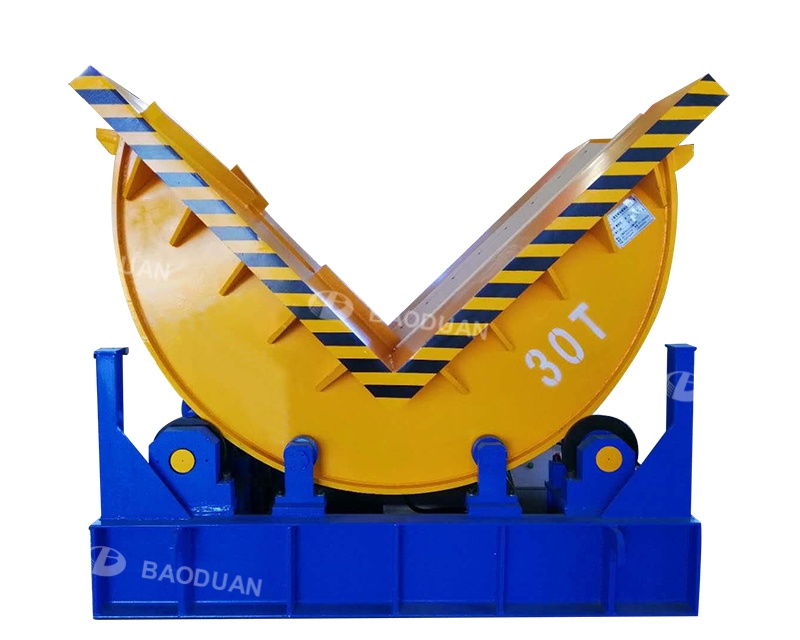To ensure that the electric flipping machine complies with relevant safety standards, it is necessary to control the entire process of design and development, production and manufacturing, testing and certification, and use and maintenance, and develop a systematic plan based on the standard requirements of the target market. The following are specific implementation steps and key measures:
Early stage: Clarify the safety standard requirements of the target market
There are differences in standard frameworks and core indicators among different countries/regions, and it is necessary to first "accurately benchmark" to avoid the cost of later rectification.
Identify the core standard system
First, clarify the application scenarios of the product, and then search for the corresponding local standards:
China: It is required to comply with the "Basic Concepts and Design Principles for Mechanical Safety" (GB/T 15706), "Safety Requirements for Electric Transport Vehicles" (GB/T 3811), etc. If electrical safety is involved, it is also required to comply with the "Safety of Household and Similar Electrical Appliances" (GB 4706.1);
EU: Must comply with the Machinery Directive and refer to coordinated standards;
USA: Must comply with UL standards and OSHA mechanical protection requirements;
Japan: Requires PSE certification and compliance with the Electrical Equipment Safety Law and JIS standards.
Disassemble the core indicators of the standard
Extract 'mandatory requirements' from standard text to avoid missing key items, such as:
Mechanical safety: protective devices, stability, emergency stop function;
Electrical safety: insulation resistance, grounding continuity, leakage protection, overload/short circuit protection;
Operational safety: human-computer interaction design, warning signs.
Mid term: Compliance control throughout the entire process from design to production
The core of compliance is to embed standard requirements throughout the entire product lifecycle, rather than conducting additional testing later on.
1. Design phase: Source compliance guided by standards
Integrating safety design into the plan
Following the logic of "risk assessment design avoidance protection supplement":
Firstly, conduct a risk assessment: identify the risks of the flipping machine in scenarios such as "start, flip, stop, and malfunction", and refer to the risk assessment methods in GB/T 16855.1 or EN ISO 12100;
Further risk mitigation can be achieved through design, such as designing anti rollover support structures for "cargo dumping"; For "electrical shock", double insulated casing and waterproof rating are adopted;
Supplementary protective devices: If the risk cannot be completely avoided, mandatory protection measures such as "flip angle limiter", "dual hand start button", and "emergency stop button" need to be installed.
Select compliant components
Key components must comply with corresponding standards to avoid "overall compliance but non compliant components":
Motor: Must pass national 3C certification, UL certification or CE certification, and have matching power;
Electrical components: Circuit breakers and contactors must comply with GB 10963.1 or IEC 60898;
Protective material: The protective cover needs to be made of materials that meet the strength standards and have no sharp edges.
2. Production stage: Ensure that the manufacturing process meets the design requirements
Develop compliant production standards
Translate standard requirements into executable production processes, such as:
Electrical wiring: strictly follow the EN 60204-1 or GB 5226.1 specifications for wiring, ensuring that the grounding resistance is ≤ 4 Ω;
Welding process: The welding of key structures must comply with GB/T 985.1 to avoid virtual welding causing load-bearing failure;
Installation of protective devices: The protective cover must be firmly fixed and have a safe distance of ≥ 50mm from the moving parts.
Process inspection and error correction
Establish key process inspection points, such as:
Before each device leaves the factory, test the "emergency stop function";
Sampling inspection for electrical safety: Use an insulation resistance tester to test for cold insulation resistance ≥ 20M Ω;
Mechanical load test: Load at 1.2 times the rated load to test the stability of the flipping process.
Post production: Consolidate compliance through certification, documentation, and maintenance
1. Apply for authoritative certification and obtain compliance certificates
Submit certification applications for the target market, such as:
Export to the EU: CE certification is required;
Export to the United States: requires UL certification;
Domestic sales: 3C certification is required.
During the certification process, it is necessary to provide product drawings, parts lists, risk assessment reports, and test data in coordination.
2. Improve technical documentation to meet traceability and usage requirements
Write "technical documents" according to standard requirements, such as:
The EU Machinery Directive requires the provision of "technical construction documents", including design calculations, test reports, and compliance statements;
Domestically, it is required to provide a "product user manual" that clearly specifies safety operating procedures and warning signs.
The document needs to be archived for future reference, and the language must comply with local requirements.
3. Guide users to use and maintain correctly to avoid compliance failure
Provide users with 'safe usage training', which includes:
The safety limit of the equipment;
Emergency situation handling.
Clear maintenance requirements, such as:
Check if the protective devices are in good condition every month;
Quarterly testing of electrical grounding effectiveness;
Every year, a professional organization is invited to conduct a 'compliance review' to ensure that the equipment meets the standards in the long term.
Special scenario: Compliance adjustments for customized equipment
If the electric flipping machine is a "customized product", additional special standards must be met:
Food industry: must comply with "hygiene standards";
Explosion proof environment: It must comply with explosion-proof standards, and motors and electrical components must be selected with explosion-proof rating ≥ Ex d IIB T4.

In summary, the core logic for ensuring compliance of electric flipping machines is "benchmarking first, then designing, strict production, strong certification, and full maintenance". Safety standards need to be integrated into every aspect of the product from "drawings" to "use", while adjusting details based on the specificity of the target market to avoid compliance risks caused by differences in standards.

Shanghai Baoduan Machinery Manu-facturing Co., LTD is located inBaoshan DistrictShanghai. Is a professional equipment manufacturing.

About
Copynght @ Shanghai Baoduan Machinery Manufacturing Co, LTD. All rights reserved
SitemapThis website uses cookies to ensure you get the best experience on our website.
Comment
(0)